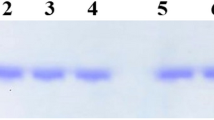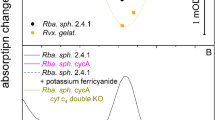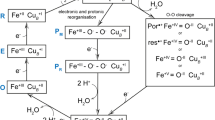Abstract
IT is generally agreed that reduced cytochrome c shows absorption bands in the visible spectrum at 550 mµ (α-band) and at 520 mµ (β-band); in fact, the presence of these two absorption bands is the principal means of detecting reduced cytochrome c in a biological object. Keilin and Hartree1 have observed the absorption bands of cytochrome cdissolved in 50 per cent glycerol and in the vitrified or devitrified states at the temperature of liquid air or oxygen, a procedure by which the absorption bands can be intensified and sharpened; under these conditions they report that a fine satellite band appears next to the α-band on its short-wave side, and the β-band appears to be a complex of several peaks. In connexion with studies on the cytochrome absorption bands of Protozoa2, we have examined the absorption bands of two commercial preparations of cytochrome c (beef heart, salt-free, Sigma Chemical Co.; Boehringer und Söhne, Mannheim) using the liquid-air cooling technique of Keilin and Hartree. A0.07 per cent (w/v) solution of Sigma cytochrome c and a 0.2 per cent (w/v) of Boehringer cytochrome c in 70 per cent (v/v) glycerol buffered at pH 7.0 with 1/50 M phosphate were either oxidized with potassium ferricyanide (2.5 m.M) or reduced with sodium sulphoxylate (in excess) and examined in the liquid state (23° C.) and after cooling to −196° C. in liquid nitrogen in a flattened ‘Pyrex’ tube (light path approximately 5 mm.). The higher concentration of the Boehringer cytochrome c was necessary in order to reach the same degree of absorption (O.D. 0.4) as the Sigma preparation at 550 mµ. 70 per cent glycerol proved to be more satisfactory than the 50 per cent used by Keilin and Hartree for observation of the absorption lines. The observations were made with a Zeiss Mikro-Specktralokular (Abbe) using a carbon arc lamp (Phywe 8150) as the source of light, and placing the cytochrome preparation above the microscope condenser. With the vitrified material the observations were completed within 30 sec. after removal from the liquid nitrogen. The spectroscope scale was standardized against the mercury line at 546 mµ. Both commercial preparations of cytochrome c showed exactly the same extinction bands, and the results in Table 1 therefore apply to both.
This is a preview of subscription content, access via your institution
Access options
Subscribe to this journal
Receive 51 print issues and online access
$199.00 per year
only $3.90 per issue
Buy this article
- Purchase on Springer Link
- Instant access to full article PDF
Prices may be subject to local taxes which are calculated during checkout
Similar content being viewed by others
References
Keilin, D., and Hartree, E. F., Nature, 164, 254 (1949).
Max Møller, K., and Prescott, D. M., Exp. Cell Res., 9, 375 (1955).
Tsou, C. L., Biochem. J., 49, 362 (1951).
Smith, L., in “Methods of Biochemical Analysis”, 2, 427 (editor D. Glick, Interscience Pub., New York and London, 1955).
Author information
Authors and Affiliations
Rights and permissions
About this article
Cite this article
MAX MØLLER, K., PRESCOTT, D. Spectroscopic Observations on Commercial Preparations of Cytochrome c . Nature 176, 1121–1122 (1955). https://doi.org/10.1038/1761121a0
Issue Date:
DOI: https://doi.org/10.1038/1761121a0
This article is cited by
Comments
By submitting a comment you agree to abide by our Terms and Community Guidelines. If you find something abusive or that does not comply with our terms or guidelines please flag it as inappropriate.



